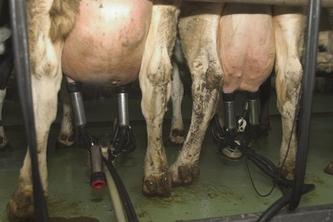
Mastitis in Cattle
What is Mastitis?
Mastitis, a common condition in dairy herds, is an inflammation of the
mammary gland or udder of the cow, usually caused by an invasion of bacteria.
Mastitis and resulting infection can significantly impair milk production. The majority of mastitis cases involve only one of the cow’s
teats, however the infection may spread among all four. Milk is still
produced, but the overall yield is lower, reducing profitability. Mastitis
may also challenge reproduction by reducing fertility and delaying the
occurrence of the cow’s heat cycle.

Types and Symptoms of Mastitis
There are two types of mastitis: infectious and non-infectious. Only about 1% of mastitis cases are non-infectious, which may be a result of physical injury, whereas infectious mastitis is a result of an infection.
Within these two types of mastitis, are four categories: Peracute, Acute, Subactue, and Subclinical.
- Peracute (most severe) symptoms include a red and swollen bag with extreme sensitivity to the touch, possible fever, shivering, weight loss, decrease in appetite, and visibly abnormal milk.
- Acute mastitis is detected by severe inflammation, some signs of fever and mild depression.
- With Subacute, symptoms on the bag are milder, and there is minimal or no display of fever or depression.
- Subclinical mastitis is the inflammation of the mammary gland without displaying any symptoms.
What causes mastitis and how can it be prevented?
Many conditions can lead to mastitis spreading throughout a herd- some contagious and some environmental. Cattle held in confined areas with high fly populations and older cattle are usually more susceptible. Another factor might be the size and shape of the teat, as a larger diameter means a wider entrance for bacteria. Mastitis is mainly spread by flies carrying the disease, but occasionally it is transferred from cow to cow by cross suckling (calf feeding from multiple cows). Most mastitis cases occur in the first month of lactation, but as long as the teat is not sealed off, the udder is at risk. Preventing mastitis begins with the nutritionist developing an effective diet plan.
Our Experience
We have unparalleled experience with agricultural investigations. We have helped many farmers and ranchers recover millions of dollars from production losses caused by bad feed, defective equipment, diseases like mastitis, and more. Domina Law Group knows how to find the experts who can determine and pinpoint the cause loss.
We have successfully proven a faulty rotary system to be the source of a Client’s herd-wide mastitis. This client was guaranteed engineering design and manufacturing that would assure thorough, comprehensive cleansing and washing when using the installed automated equipment after each milking. Further, the manufacturer and installer represented that this washing procedure would assure that communicable ailments, including mastitis, would not be transmitted from cow to cow.
However, when the vacuum system would shut down or operate inadequately, and the detachers would not function appropriately, the cows did not get milked properly and therefore developed mastitis – which in turn lead to financial losses. Our firm was hired to prove this case – we did so and our client recovered a large amount of money.
Are you and your operation potentially a victim of defective equipment or other factors out of your control? Call Domina Law Group to begin recovering your production losses today!
Mastitis Resources:









